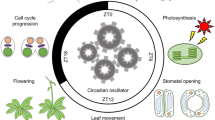Abstract
The temperature sensitive period for mutant expression was determined incubitus interruptus ofDrosophila melanogaster. Two stocks carrying the dominant alleleci D were compared, in which under the influence of temperature, mutant expression of the most conspicuous character (gap in fourth vein) changes in opposite directions.
The effective period (T.E.P.) ofci D was found to be very similar in both stocks. It is relatively short and begins after puparium formation. The T.E.P. is also the same for mutant expression on the fourth and the fifth vein. But in contrast to the 4th vein character, the 5th vein reacted in the same direction in both stocks.
The T.E.P. was again determined in the same two stocks after the recessive alleleci had been introduced instead ofci D. The T.E.P. ofci in both stocks occupies a large part of the larval period including the first instar. The genetic background difference that causes opposite temperature reactions ofci D, does not show up in the temperature reactions ofci.
The significance of these facts and of T.E.P.'s in general are discussed.
Similar content being viewed by others
References
Baron, A. L. (1935). Facet number inDrosophila melanogaster as influenced by certain genetic and environmental factors.J. Exp. Zool. 70: 461–490.
Goldschmidt, R. B. (1938). Physiological genetics. Mc Graw Hill, New York and London.
Henke, K., E. von Finck &Sen Yun Ma (1941). Über sensible Perioden für die Ausbildung von Hitzemodifikationen beiDrosophila und die Beziehungen zwischen Modifikationen und Mutationen.Z. Ind. Abst. Vererbgsl. 79: 267–316.
Pantelouris, E. M. (1957). Size response of developingDrosophila melanogaster to temperature.J. Genetics 55: 507–510.
Rendel, J. M. (1959). Variation and dominance at thescute locus inDrosophila melanogaster.Austr. J. Biol. Sc. 12: 524–533.
Robertson, F. W. (1960). Studies in quantitative inheritance. XII. Cell size and number in relation to genetic and environmental variation in body size inDrosophila.Genetics 44: 869–894.
Sang, J. H. &J. M. Mc Donald (1954). Production of phenocopies inDrosophila using salts, particularly sodium metaborate.J. Genetics 52: 392–412.
Scharloo, W. (1961). Temperature and mutant expression.Experientia 17: 121.
Scharloo, W. (1962). The influence of selection and temperature on a mutant character (ci D) inDrosophila melanogaster.Arch. Néerl. Zool. 14: 431–512.
Scharloo, W. (1964). Mutant expression andc analization.Nature 201: (in print).
Vogt, M. (1947). Zur labilen Determination der Imaginalscheiben inDrosophila. III.Biol. Zbl. 66: 81–105.
Zimm, G. G. (1951). An analysis of growth abnormalities associated with the eye mutantLobe inDrosophila melanogaster.J. Exp. Zool. 116: 289–319.
Author information
Authors and Affiliations
Rights and permissions
About this article
Cite this article
Scharloo, W., Nieuwenhuijs, A.M. Temperature sensitive periods ofcubitus interruptus mutants inDrosophila melanogaster . Genetica 35, 15–27 (1964). https://doi.org/10.1007/BF01804871
Received:
Issue Date:
DOI: https://doi.org/10.1007/BF01804871




